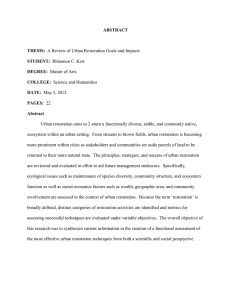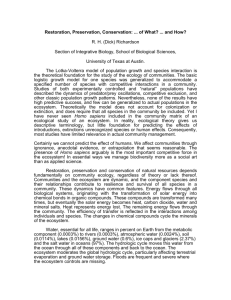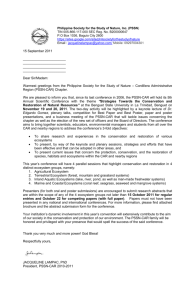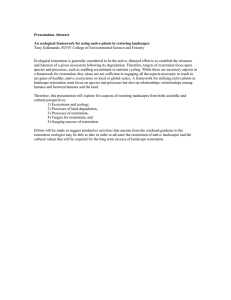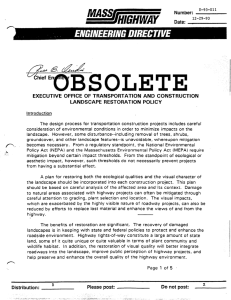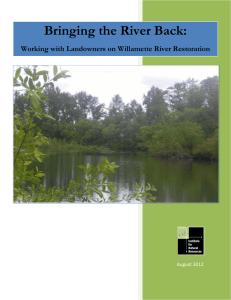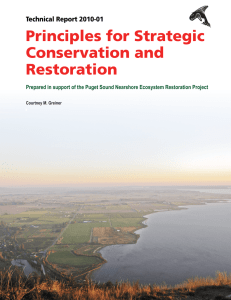Oregon RC&D Conference Redmond, Oregon April 23, 2010
advertisement
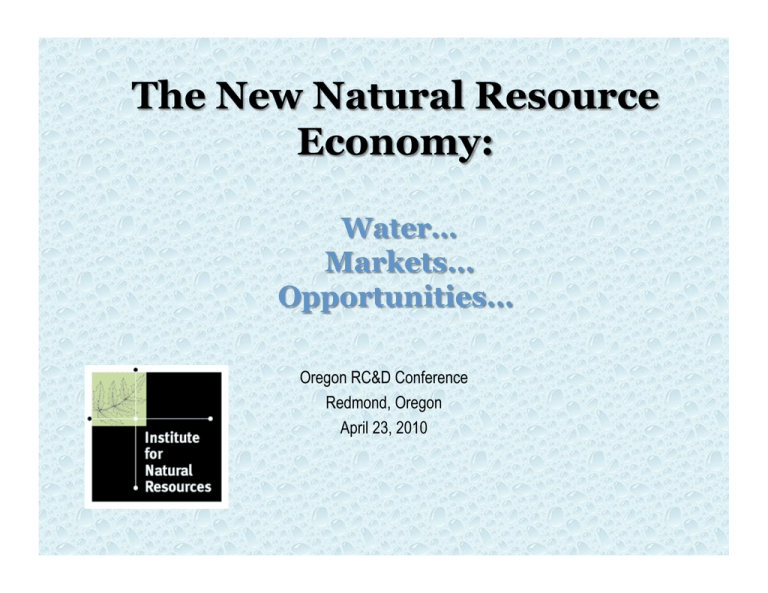
Oregon RC&D Conference Redmond, Oregon April 23, 2010 • When the well is dry, we learn the worth of water. • In the American West, water flows uphill to money. • Used to measure in pounds and acres and gallons and board feet: commodity production • Now measure in years and local jobs and stable communities: natural resources as long-term assets • Originated with Australian Landcare program • Taken up in Europe, South Africa, Iceland, Canada • Adopted in western U.S. under Western Governors’ Association’s Policy Resolution 09-11; Montana’s Restore Montana program; Arizona’s Forest Health Advisory and Oversight Councils • Pioneer efforts in watershed management and restoration • Forestry: restoration, wildfire mitigation, biomass utilization • Sustainable agriculture, bioenergy, ecosystem services transactions Implementing irrigation efficiency (engineering, pipe sales) Conservation/restoration revenue opportunities (water “markets,” riparian restoration funding, future hydro revenues) Sustainable ag practices (carbon, temperature, salmon credits; reduced chemical inputs) Expanding restoration economy (incentive $, mitigation exchanges, water transactions, tourism & recreation $) Improved long-term stability of human + landscape systems “Markets” developing slowly: many “public good” aspects + high transaction costs + fluctuating supply + limited opportunities for small landowners Arguments currently swirling: – Reallocation from agricultural to urban uses – Large economic losses for areas of origin – Large hydrologic effects caused by interbasin trades “Markets”: a possible solution MBIs and PES build on local solutions and development, place-based values, potential to benefit whole communities Importance of transitional institutions right now 1. Collective engagement of all rights-holders; attention to preserving agricultural uses while considering environmental uses 2. Develop shared vision among potential and current users 3. Identify demand as well as supply 4. Understand how to measure services, or market cannot work Essential components: – Choice (time and $) – Engagement with landowners (knowledge and aggregation) – Engagement with businesses (profit lines) – Regulatory changes (predictability) – Reducing risk (govt role?) – Monitoring as opportunity (data analysis pods) Whether “markets” develop or not… • Brokerage: combining restoration activities, working with smaller acreages – Research: understanding the market opportunities – Cooperative entrepreneurship: combining the restoration opportunity with funding options • Training: – ES auditors, ES project designers, ES monitors, restoration data analysts (pods of geeks) COMMODITY % OF FARM INCOME POTENTIAL CLIENT Wheat 10% World market Timber 25% World market Potatoes 15% Regional/local market Carbon credits 15% Steel company Water filtration credits 20% Urban water auth/utility Biodiversity credit 5% Philanthropic trust Temperature credit 10% Cost sharing, w’shed mgt • Ecosystem service districts: linking • Landscape labeling: distinguishing • Restoration monitoring analysis: integrating • Could provide an institutional mechanism to help ensure natural capital is maintained • Matches: – Local control with regional and national networks – RCD goals and missions – Farm and watershed scale initiatives – Potential links w/Watershed Councils – Ecology + economics + ecosystem services + legal issues involved in managing ecosystems for the good of a community • Information generator eg compare cost of service provision through natural and built means • Coordinating function to provide information exchange among districts, highlight conflicting activities • Land use powers or zoning authority • Taxation authority to provide funds to help allocate services optimally through pricing • Identify, match, and map market mechanisms with available ES + associated occupations – Strategic use of mapping and information tools for planning and match with incentive programs – Jobs: assessors, consultants on strategic conservation, designers and certifiers, earth movers, monitors, analysts. • Link measures of ES to landholder actions – Quantify enviro benefits associated w/on ground work regional planning and targeting for scarce public funds – Thus help ID other investors and clients who can involve landowners who are not “strategically located” • Local rules regulate trade landscape labeling • Local communities linked to global communities; local equity important • Local co-operatives, global partnerships and collaborations • Local groupings recognize the need to share experiences and solutions 1. Combining PES with product labeling based on delivering/protecting ES 2. Deliver benefits of PES through social and infrastructural investments 3. Develop a nationally/ internationally recognizable format for verifying ES provision • Design market mechanisms that encourage investment of all kinds in natural resource management • Link ecosystem service production with willing investors = local and global marketing • Potential product premiums • Ecological benefits: – Manage at a landscape level – Consider suites of ecosystem services – Engage landowners in broader goals • Social benefits: – Reduce transaction costs – Improve inclusiveness – Allow flexibility around changing markets – Social pressure to limit freeriding – Fits with truffle, trail projects • Distributed networks of information, local to global • Locally-based knowledge development in the field, feeds into verification systems • Fits with energy analysis and tourism development • Dual meaning: biophysical systems + human systems, communities create and change • ESD and landscape labeling are communitybased concepts • Opportunities abound for defining how a community wants to market its available Ecosystem Services sally.duncan@oregonstate.edu Institute for Natural Resources 541 737 9931
